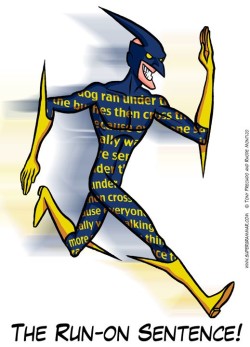 Waaaaay back, when I was in junior high school, I remember my English teacher telling us that if we had even one run-on sentence in an essay in high school or college, we would get an F for the entire essay. I don’t know if that ever came to pass; I like to think I don’t remember because I would never write a run-on sentence. And don’t believe I ever failed a paper.
Waaaaay back, when I was in junior high school, I remember my English teacher telling us that if we had even one run-on sentence in an essay in high school or college, we would get an F for the entire essay. I don’t know if that ever came to pass; I like to think I don’t remember because I would never write a run-on sentence. And don’t believe I ever failed a paper.
At about the same time, or probably even earlier, I remember being told in math class that we had better learn the metric system because that is what we would be using in the near future. We all know how that one turned out!
I think that maybe the run-on sentence warning may have gone the same way. I have no idea whether or not teachers fail a student who writes one run on in an essay. I, however, do take off points for anything a student writes with more than one run-on sentence. More than one run on indicates to me that the student may not really understand what a sentence is.
What is a run-on sentence, anyway? What is this evil thing that people write? Simply put, a run on is actually two complete sentences without the proper punctuation between them. Generally, it is two complete sentences separated by a comma, also known as a comma splice. A comma is not a strong enough punctuation mark to separate two complete sentences by itself.
Yes, there are some authors who do separate their sentences with commas in novels. Perhaps it indicates some pacing technique. I don’t like it. As an editor, I generally change it, especially in a book for children or teens. They need to see books as bastions of correctness, right?
Here is a run on sentence (also a comma splice):
My sister had a job interview yesterday, she hopes she gets the job. (Ring the Run-On Buzzer loudly!)
Fortunately, run ons are easy to fix, and there are many repair options. The simplest is to simply change the comma to a period and begin a new sentence with a capital letter:
My sister had a job interview yesterday. She hopes she gets the job.
For those who are not afraid of the semicolon, you may use a semicolon if the sentences are related. In this case, I would say they are.
My sister had a job interview yesterday; she hopes she gets the job.
Perhaps in this case they aren’t:
My sister had a job interview yesterday. I would hate to work in the company she interviewed with.
If the sentences are closely related, you can also keep the comma and add a conjunction along with it:
My sister had a job interview yesterday, and she hopes she gets the job.
Those are the three easiest and most common ways to fix a run-on sentence. There are other ways. You can separate them with a colon if the second sentence is a result of, or an explanation of, the first sentence. However, you don’t need to use a colon in this case, so you might want to avoid using the colon to separate sentences, just in case it isn’t appropriate for the particular sentences:
My sister had a job interview yesterday: she graduates from college in two weeks. (No capital letter is necessary to begin the second sentence.)
There are also some more creative ways to write the sentence:
My sister had a job interview yesterday — she hopes she gets the job.
or even
My sister had a job interview yesterday (she hopes she gets the job).
Not common, but not really incorrect. The first three fixes are the recommended ones.
Join me again next week for Deadly Grammar Sin No. 2, which will remain a secret.
&&&&&&&&&&&&&&&&&&&&&&&&&&&&&&&&&&&&&&&&&&&&&&&&&&&&&&&&&&&&
The Best Grammar Workbook Ever is now available in paperback on Amazon and other online booksellers, available to order from your favorite bookstore, and available to purchase as a PDF from my website.
If you received a complimentary PDF to review, a review would be appreciated! Thank you to all who have already posted a review. If you purchase the book, of course a review would also be greatly appreciated!
If you are in the area, I will be at the Hampton Inn in Vacaville tomorrow, Sunday, April 12, from 10-4 for BookFest Solano.



I’m wondering if your going to do a post on sentence fragments. It might be a good idea to research that since you have a fragment the last sentence of the first paragraph (unless you were telling us we shouldn’t believe you would fail). Your inconsistent hyphenation of “run-on” also bothered me.
Funny you should mention it. The second deadly sin is fragments! I don’t know which sentence you are referring to, but I do use fragments in my books and in my blog posts. However, I wouldn’t use a fragment in a formal letter, such as a cover letter. I am quite aware of what a fragment is! My hyphenation of run on was not inconsistent. It is hyphenated when used as an adjective preceding the word “sentence.” It is not hyphenated when used as a noun. That is the general rule of compound adjectives. The grammar diva would never be that conspicuously inconsistent!
A comma splice doesn’t qualify as a run-on sentence in my book. How about this doozy, from an actual piece I copy-edited?
“Partisans devised a neo–art nouveau masterpiece of fluid, seamless walls and ceilings, and appointments of computer-generated, machine-carved, hand-oiled, contoured mahogany panels – a phantasmagoria of silken yet muscular structural members that evokes the smooth contours of a lean, efficient human body.”
Having writers (and editors) read such pileups aloud works well—a great technique if they’re receptive.
That is a long sentence! It is confusing, yet to my definition, it is not a run on. It is one complete thought. My definition of a run-on sentence has always been one that needs a period, semicolon, colon, or conjunction somewhere because it is more than one sentence strung together. I may be wrong, but that has always been my understanding.
One of the techniques I used to help students overcome the run-on sentence problem was to have them read aloud their texts. Even students with a shaky grasp of sentence structure usually can hear the problem.
Another technique was to have students submit papers with a specified number of sentences. This requirement forced them to think in sentences.
And finally, I would give students mock drafts (prepared by me) with run-on sentences and have them edit the material: “Find and correct the three run-ons in this book review.”
These are great teaching ideas! I especially like the second one! But then, my students might just write short, choppy simple sentences, which we don’t want either!
Precisely! And I am not sure, but maybe Faulkner?